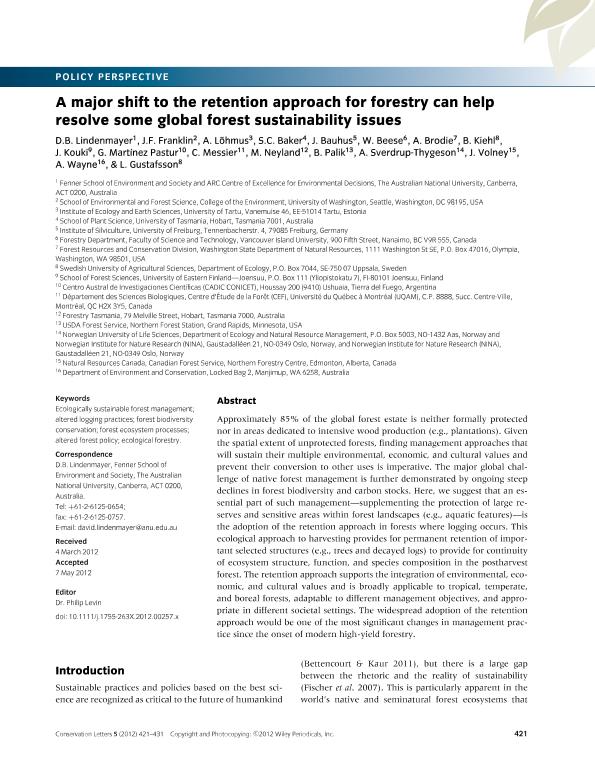Mostrar el registro sencillo del ítem
dc.contributor.author
Lindenmayer, D.B.
dc.contributor.author
Franklin, J.F.
dc.contributor.author
Lõhmus, A.
dc.contributor.author
Baker, S.C.
dc.contributor.author
Bauhus, J.
dc.contributor.author
Beese, W.
dc.contributor.author
Brodie, A.
dc.contributor.author
Kiehl, B.
dc.contributor.author
Kouki, J.
dc.contributor.author
Martínez Pastur, Guillermo José

dc.contributor.author
Messier, C.
dc.contributor.author
Neyland, M.
dc.contributor.author
Palik, B.
dc.contributor.author
Sverdrup Thygeson, A.
dc.contributor.author
Volney, J.
dc.contributor.author
Wayne, A.
dc.contributor.author
Gustafsson, L.
dc.date.available
2020-10-20T19:17:22Z
dc.date.issued
2012-12
dc.identifier.citation
Lindenmayer, D.B.; Franklin, J.F.; Lõhmus, A.; Baker, S.C.; Bauhus, J.; et al.; A major shift to the retention approach for forestry can help resolve some global forest sustainability issues; Wiley; Conservation Letters; 5; 6; 12-2012; 421-431
dc.identifier.issn
1755-263X
dc.identifier.uri
http://hdl.handle.net/11336/116187
dc.description.abstract
Approximately 85% of the global forest estate is neither formally protected nor in areas dedicated to intensive wood production (e.g., plantations). Given the spatial extent of unprotected forests, finding management approaches that will sustain their multiple environmental, economic, and cultural values and prevent their conversion to other uses is imperative. The major global challenge of native forest management is further demonstrated by ongoing steep declines in forest biodiversity and carbon stocks. Here, we suggest that an essential part of such management—supplementing the protection of large reserves and sensitive areas within forest landscapes (e.g., aquatic features)—is the adoption of the retention approach in forests where logging occurs. This ecological approach to harvesting provides for permanent retention of important selected structures (e.g., trees and decayed logs) to provide for continuity of ecosystem structure, function, and species composition in the postharvest forest. The retention approach supports the integration of environmental, economic, and cultural values and is broadly applicable to tropical, temperate, and boreal forests, adaptable to different management objectives, and appropriate in different societal settings. The widespread adoption of the retention approach would be one of the most significant changes in management practice since the onset of modern high-yield forestry.
dc.format
application/pdf
dc.language.iso
eng
dc.publisher
Wiley

dc.rights
info:eu-repo/semantics/openAccess
dc.rights.uri
https://creativecommons.org/licenses/by-nc-sa/2.5/ar/
dc.subject
ALTERED FOREST POLICY
dc.subject
ALTERED LOGGING PRACTICES
dc.subject
ECOLOGICAL FORESTRY
dc.subject
ECOLOGICALLY SUSTAINABLE FOREST MANAGEMENT
dc.subject
FOREST BIODIVERSITY CONSERVATION
dc.subject
FOREST ECOSYSTEM PROCESSES
dc.subject.classification
Silvicultura

dc.subject.classification
Agricultura, Silvicultura y Pesca

dc.subject.classification
CIENCIAS AGRÍCOLAS

dc.title
A major shift to the retention approach for forestry can help resolve some global forest sustainability issues
dc.type
info:eu-repo/semantics/article
dc.type
info:ar-repo/semantics/artículo
dc.type
info:eu-repo/semantics/publishedVersion
dc.date.updated
2020-04-24T18:08:43Z
dc.journal.volume
5
dc.journal.number
6
dc.journal.pagination
421-431
dc.journal.pais
Estados Unidos

dc.description.fil
Fil: Lindenmayer, D.B.. The Australian National University,; Australia
dc.description.fil
Fil: Franklin, J.F.. University of Washington; Estados Unidos
dc.description.fil
Fil: Lõhmus, A.. University of Tartu; Estonia
dc.description.fil
Fil: Baker, S.C.. University of Tasmania; Australia
dc.description.fil
Fil: Bauhus, J.. Albert Ludwigs University of Freiburg; Alemania
dc.description.fil
Fil: Beese, W.. University of Vancouver; Canadá
dc.description.fil
Fil: Brodie, A.. No especifíca;
dc.description.fil
Fil: Kiehl, B.. Swedish University of Agricultural Sciences; Suecia
dc.description.fil
Fil: Kouki, J.. University of Eastern Finland; Finlandia
dc.description.fil
Fil: Martínez Pastur, Guillermo José. Consejo Nacional de Investigaciones Científicas y Técnicas. Centro Austral de Investigaciones Científicas; Argentina
dc.description.fil
Fil: Messier, C.. Université du Québec a Montreal; Canadá
dc.description.fil
Fil: Neyland, M.. University of Tasmania; Australia
dc.description.fil
Fil: Palik, B.. No especifíca;
dc.description.fil
Fil: Sverdrup Thygeson, A.. Norwegian University of Life Sciences; Noruega
dc.description.fil
Fil: Volney, J.. Canadian Forest Service; Canadá
dc.description.fil
Fil: Wayne, A.. No especifíca;
dc.description.fil
Fil: Gustafsson, L.. Swedish University of Agricultural Sciences; Suecia
dc.journal.title
Conservation Letters
dc.relation.alternativeid
info:eu-repo/semantics/altIdentifier/url/http://onlinelibrary.wiley.com/doi/10.1111/j.1755-263X.2012.00257.x/abstract
dc.relation.alternativeid
info:eu-repo/semantics/altIdentifier/doi/http://dx.doi.org/10.1111/j.1755-263X.2012.00257.x
Archivos asociados
